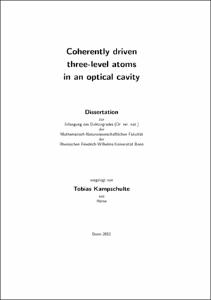Coherently driven three-level atoms in an optical cavity

Coherently driven three-level atoms in an optical cavity

| dc.contributor.advisor | Meschede, Dieter | |
| dc.contributor.author | Kampschulte, Tobias | |
| dc.date.accessioned | 2020-04-17T20:00:59Z | |
| dc.date.available | 2020-04-17T20:00:59Z | |
| dc.date.issued | 17.02.2012 | |
| dc.identifier.uri | https://hdl.handle.net/20.500.11811/5271 | |
| dc.description.abstract | We experimentally realize strong light-matter coupling of a single cesium atom to a single mode of a high-finesse optical cavity. In this regime, the optical properties of one atom change the transmission spectrum of the resonator significantly. The two hyperfine ground states of cesium can be distinguished by the relative transmission of a weak probe beam coupled to the cavity. Here, we coherently couple the two hyperfine ground states via an electronically excited state with two-photon transitions. In the first experimental configuration, two-photon Raman transitions are driven between the two ground states while continuously observing the atomic state. I present a new in-situ spectroscopic technique for the internal hyperfine and Zeeman-sublevel dynamics of an atom inside the cavity mode, using time-dependent Bayesian analysis of quantum jumps. In the second configuration, the three-level atomic structure forms the basis of Electromagnetically Induced Transparency (EIT). The modification of the absorptive and dispersive properties of an atom by destructive interference leads to strong changes in the transmission of the probe beam. Our observations are qualitatively described in a semiclassical picture in the weak-probing limit. I furthermore present a fully quantum mechanical model, where deviations from the weak-probing limit, dephasing effects and other hyperfine states are taken into account to fit our data quantitatively. Moreover, I formulated an extension of the semiclassical model to highlight a conceptual contrast to the quantum model. Additionally, the EIT effect is connected with a strong cooling effect, resulting in a 20-fold increase of the storage time of the atoms inside the cavity. I present further results of investigations of this effect where the atoms are trapped and EIT-cooled outside the cavity. From microwave sideband spectra it can be inferred that almost 80% of the atoms are in the ground state of motion along the trap axis. | en |
| dc.language.iso | eng | |
| dc.rights | In Copyright | |
| dc.rights.uri | http://rightsstatements.org/vocab/InC/1.0/ | |
| dc.subject.ddc | 530 Physik | |
| dc.title | Coherently driven three-level atoms in an optical cavity | |
| dc.type | Dissertation oder Habilitation | |
| dc.publisher.name | Universitäts- und Landesbibliothek Bonn | |
| dc.publisher.location | Bonn | |
| dc.rights.accessRights | openAccess | |
| dc.identifier.urn | https://nbn-resolving.org/urn:nbn:de:hbz:5n-27673 | |
| ulbbn.pubtype | Erstveröffentlichung | |
| ulbbnediss.affiliation.name | Rheinische Friedrich-Wilhelms-Universität Bonn | |
| ulbbnediss.affiliation.location | Bonn | |
| ulbbnediss.thesis.level | Dissertation | |
| ulbbnediss.dissID | 2767 | |
| ulbbnediss.date.accepted | 05.09.2011 | |
| ulbbnediss.dissNotes.extern | Copyright note: Readers may view, browse, and/or download material for temporary copying purposes only, provided these uses are for noncommercial personal purposes. Except as provided by law, this material may not be further reproduced, distributed, transmitted, modified, adapted, performed, displayed, published, or sold in whole or part, without prior written permission from the American Physical Society. | |
| ulbbnediss.institute | Mathematisch-Naturwissenschaftliche Fakultät : Fachgruppe Physik/Astronomie / Institut für angewandte Physik (IAP) | |
| ulbbnediss.fakultaet | Mathematisch-Naturwissenschaftliche Fakultät | |
| dc.contributor.coReferee | Reichel, Jakob |
Dateien zu dieser Ressource
Das Dokument erscheint in:
-
E-Dissertationen (4378)




